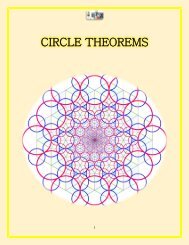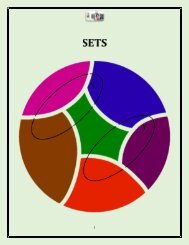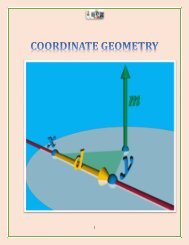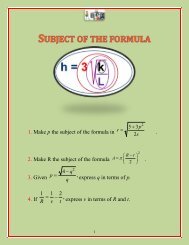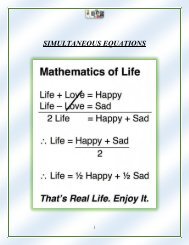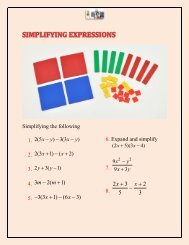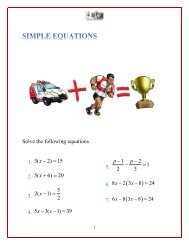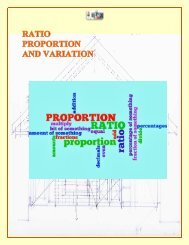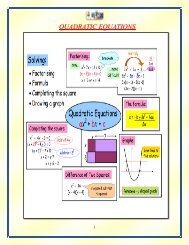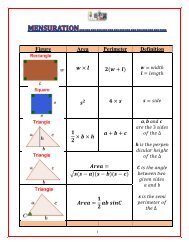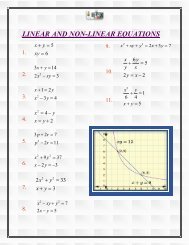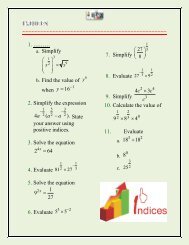GEOMETRY
Create successful ePaper yourself
Turn your PDF publications into a flip-book with our unique Google optimized e-Paper software.
1. In the diagram below ACE and BCD are straight lines.<br />
i. Calculate the value of the angle marked x°<br />
ii. Calculate the value of the angle marked y°.<br />
iii. Calculate the value of the angle marked z°.<br />
[Give two reasons for your answers.]<br />
2. In the diagram below PQR is a right angled triangle. PQ is<br />
parallel to TR.<br />
PQ is 8.2 cm PT is 5.2 cm<br />
TR is 3.6 cm TS is x cm<br />
2
i. What is the area of the trapezium PQRT?<br />
ii. Find x which is the distance TS.<br />
iii. Find tan θ.<br />
3. In the triangle PQR<br />
shown below, PQ =<br />
QR and QR = PR.<br />
i. What is the name<br />
of this type of<br />
triangle?<br />
ii. What are the<br />
values of the<br />
angles marked x°<br />
and y°?<br />
4. Below is the plan of a farmer’s field.<br />
What is the total area of the field?<br />
3
5. Use a ruler, a pencil, and a pair of compass only for this<br />
question.<br />
i. Draw a line segment, PQ, 7 cm long.<br />
ii. Construct a line segment, LM, the perpendicular<br />
bisector of PQ, such that LM cuts PQ at O, and<br />
OL = OM = cm.<br />
iii. Form a parallelogram PLQM by joining the points P, L,<br />
Q and M.<br />
iv. Measure and state the size of angle MPL.<br />
v. What type of parallelogram is PLQM? Give a reason<br />
for your answer.<br />
6. The shape ABCD below is a trapezium.<br />
The angle CAD is 19°.<br />
The angle ACD is 98°.<br />
BCE is a straight line.<br />
i. What is the size of the angle marked with the letter p?<br />
Give a reason for your answer.<br />
ii. What is the size of the angle marked with the letter q?<br />
Give a reason for your answer.<br />
4
7. Below is the diagram (not drawn to scale) of a regular<br />
pentagon.<br />
i. Calculate the value of<br />
the angle marked q.<br />
ii. Calculate the value of<br />
the angle marked p.<br />
8. Find the value of x in the diagram below.<br />
9. Two angles are supplementary, if one of the angles is twice<br />
the measure of the other, what is the measure of both<br />
angles?<br />
10. An exterior angle on a regular polygon measures 36°. How<br />
many sides does the polygon have?<br />
11. Each of the exterior angle of a regular polygon is 20°. How<br />
many sides does the polygon have?<br />
5
12. The diagram below shows the quadrilateral PQRS.<br />
NQ is a straight line parallel to PS.<br />
i. What is the size of the angle marked a?<br />
Give a reason for your answer.<br />
ii. Work out the size of the angle marked b.<br />
What property did you use to come up with your<br />
solution?<br />
13. Inside the regular hexagon below is<br />
an equilateral triangle, a rhombus and<br />
a trapezium.<br />
a. What is the size of angle p?<br />
b. What is the size of angle q?<br />
c. The area of the equilateral<br />
triangle is 5cm 2 . Work out the<br />
total area of the regular hexagon.<br />
6
14. The figure below, not drawn to scale, is a regular hexagon<br />
with centre X, and XY = 6 cm.<br />
Calculate<br />
i. the size of angle YZX<br />
ii. the area of triangle YXZ, expressing your answer correct<br />
to one decimal place.<br />
iii. the area of the hexagon.<br />
15. Two circles with centres P and Q and radii 5 cm and 2 cm<br />
respectively are drawn so that they touch each other at T<br />
and a straight line XY at S and R.<br />
7
16. ….<br />
a. State with a reason<br />
i. why PTQ is a straight line<br />
ii. the length PQ<br />
iii. why PS is parallel to QR<br />
b. N is a point on PS such that QN is perpendicular to<br />
PS.<br />
Calculate<br />
i. The length PN<br />
ii. The length RS.<br />
ABCDE is a regular pentagon inscribed in a circle centre O,<br />
radius 12 cm, as shown in the diagram above, M is the<br />
midpoint of DC.<br />
i. Calculate the angle DOC (in degrees)<br />
ii. Calculate DM<br />
iii. Hence find the perimeter of the pentagon<br />
8
17.<br />
In the diagram above (not drawn to scale) ABCDEF<br />
represents a regular polygon. Given that the sum of the<br />
interior angles of an n-sided polygon is 180(n – 2)°,<br />
calculate the size of<br />
i. angle AFE<br />
ii. angle BCA<br />
18. LMNOPQ is a hexagon(not drawn<br />
to scale) with<br />
P ˆ 110 , Qˆ<br />
130 and Oˆ<br />
90 ,<br />
Lˆ Mˆ Nˆ<br />
i. Calculate the value of .<br />
ii. Given that PO = 4cm and the<br />
area of ΔNOP = 12 cm 2 .<br />
iii. Calculate the length of PN in<br />
cm, giving your answer correct<br />
to one decimal place.<br />
ˆL<br />
9
19. ….<br />
ABCDE is a pentagon, not drawn to scale, with<br />
Aˆ Bˆ Dˆ x.<br />
Angle C = 72° and angle E = 81°.<br />
Calculate the value of x.<br />
20. The angles of a quadrilateral taken in order are 90°, x°, 2x°,<br />
3x°.<br />
i. Calculate the size of the unknown angles.<br />
ii. Name the type of quadrilateral.<br />
21. The diagram, not drawn to scale, represents a regular<br />
polygon PQRST.<br />
i. Given that the sum of the<br />
interior angles of the<br />
polygon with n sides is<br />
180(n – 2)°, calculate angle<br />
TSR and angle TRS.<br />
ii. Given further that angle<br />
PQR = x°, and angle<br />
RTP = y°, show that<br />
y<br />
2. x<br />
10
22.….<br />
In the diagram above, not drawn to scale, AB is parallel to<br />
CD and EG is parallel to FH. Angle IJL = 50° and angle<br />
KIJ = 95°<br />
Calculate the values of x, y, and z showing clearly the steps<br />
in your calculations.<br />
23. In the diagram above, not<br />
drawn to scale, BG is<br />
parallel to DE, AF and CH<br />
are straight lines. Calculate<br />
the values of x and y<br />
showing clearly the steps<br />
in your calculation.<br />
11
24.<br />
ABCDE is a pentagon. The angles A, B, C, D, and E are x°,<br />
2x°, 3x°, 4x°, and 120°. Find the value of x.<br />
25. In the diagram, not<br />
drawn to scale, angles<br />
BAC = 24°, EDC = 30°<br />
and angle CED = x°.<br />
Calculate in terms of x<br />
the size of<br />
i. Angle AFD<br />
ii. Angle BFE<br />
iii. Hence deduce the<br />
value of x.<br />
26. Given that π radians = 180° express<br />
i.<br />
<br />
radians in degrees<br />
6<br />
ii. 210° in degrees<br />
12
27. In the diagram, ABC and ACD are isosceles triangles in<br />
which AB = AC = AD and<br />
BAC<br />
ACD<br />
74<br />
a. Calculate<br />
i.<br />
ii.<br />
b. What special type of quadrilateral is ABCD?<br />
CAD<br />
BCA<br />
28. State three properties which define a rhombus, with respect<br />
to its sides, angles and diagonals<br />
ABCD is a rhombus (not drawn to scale) with AO = 4.8cm<br />
and BC = 3.6 cm<br />
Calculate<br />
i. The length of AB.<br />
ii. The state of angle BAD to the nearest degree.<br />
iii. The area of ABCD.<br />
13
29.<br />
The minute hand of a clock is 25 cm long and the hour<br />
hand is 21 cm long. Calculate<br />
i. the distance moved by the tip of the hour hand when<br />
the time goes from 2 a.m. to 10 a.m. the same day.<br />
ii. the smaller angle between the hands of the clock when<br />
the time is 10 o’clock.<br />
30. In this question, use 3.14<br />
A wheel is turning at a rate of 33 revolutions per minute.<br />
Express this speed in radians per second, correct to 2<br />
significant figures<br />
14
31. …<br />
Similar Triangles<br />
32. ….<br />
In the diagram above, not drawn to scale, PQ, XY, and SR<br />
are parallel lines. QY = 10cm, YR = 5cm and XY = 3cm.<br />
i. Prove that triangle PQX and RSX are similar.<br />
ii. Calculate the lengths of PQ and RS.<br />
iii. Calculate the ratio of the areas of the triangles PQX<br />
and RSX.<br />
BAC<br />
80<br />
In the figure above, not drawn to scale,<br />
AC, MB = MC and BF is perpendicular to AC.<br />
i. Calculate the angles ABF, BMC, and MCF.<br />
ii. Show that triangles ABF and MCF are similar.<br />
. AB =<br />
15
33.<br />
Triangles PXY and PQR, not drawn to scale, are similar<br />
triangles. PX = 4 cm, XQ = 6 cm, and<br />
QR = 8 cm. Calculate<br />
i. The length of XY in cm.<br />
ii. The area of triangle PXY given that the area of triangle<br />
PQR is 50 cm 2 .<br />
34.<br />
The figure SJKM above, not drawn to scale, is a trapezium<br />
with SJ parallel to MK, angle MJK = 124°, image<br />
MSJ = 136° and SM = SJ = 50 m.<br />
a. Calculate the size of<br />
i. Angle SJM<br />
ii. Angle JKM<br />
iii. Calculate, expressing your answer correct to one<br />
decimal place, the length of MJ.<br />
16





